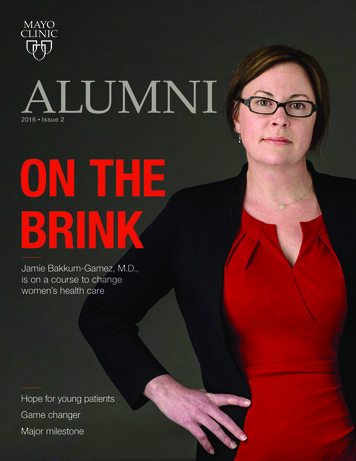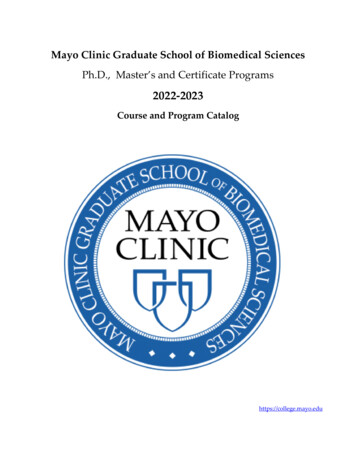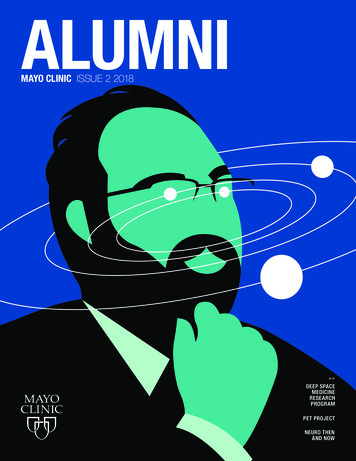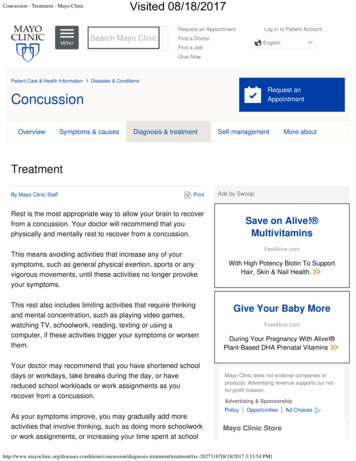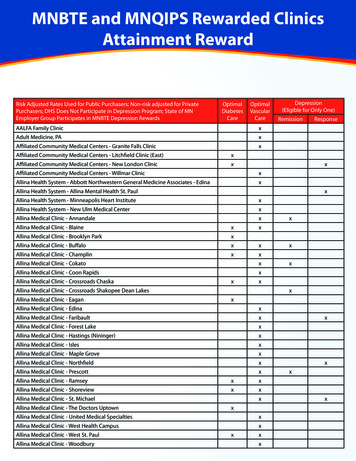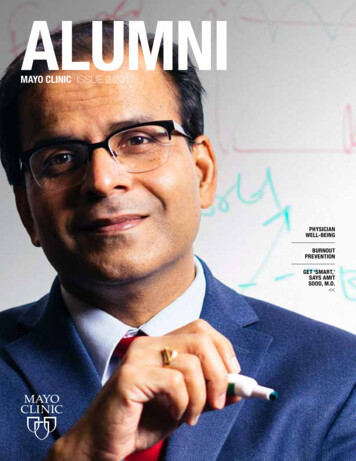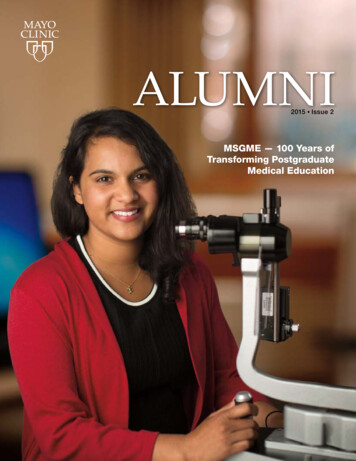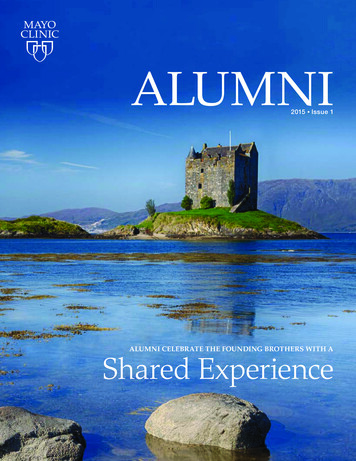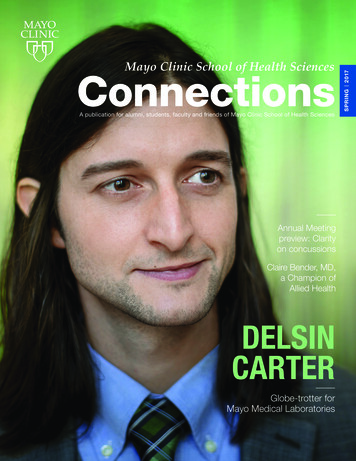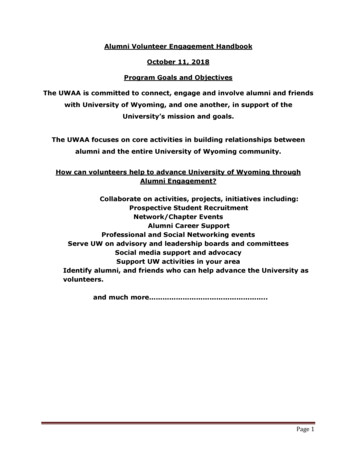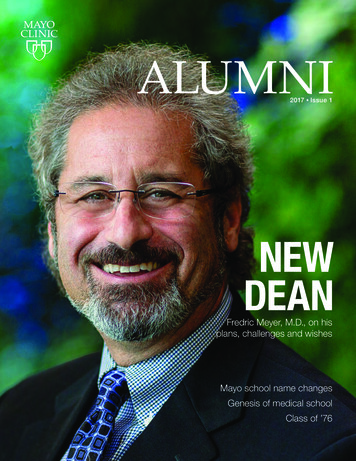
Transcription
2017 Issue 1NEWDEANFredric Meyer, M.D., on hisplans, challenges and wishesMayo school name changesGenesis of medical schoolClass of ’76
ContentsMayo Clinic Alumni 2017 Issue 1FeaturesQ&A with new education dean Fredric Meyer, M.D.2Mayo Clinic School of Medicine annual reunion8Mayo Clinic college and school name changes11On the shoulders of giantsReeja Maskey, Ph.D., and Yuici Machida, Ph.D.34Alumni Association Biennial Meeting36Distinguished Fellowship Awards37Genesis of medical school14Mayo UpdateCountdown to medical school’s Arizona campus debut20Class of ’76 — 45 years since starting medical school2238 Mayo physicians in National Academy of Medicine New ORs for Jacobson Building in RochesterAlumnus, pharma notable and Board of Trusteesmember Randolph Steer, M.D., Ph.D.30 Board of Trustees news Biomaterials for surgical bleeding Obituaries
Letter fromthe presidentI think you’ll really enjoy this issue of Mayo ClinicAlumni, which focuses on education at Mayo —education of physicians, researchers, medical studentsand allied health professionals. The stories look back— the decision to start a medical school at MayoClinic — and look forward — how the new dean foreducation foresees medical education evolving.Our Alumni Association welcomes and supportsstudents and graduates of all five schools within theMayo Clinic College of Medicine and Science (page 12)with events, promotion, and other ways to engageand stay connected to Mayo Clinic. We supportDr. Fredric Meyer’s goal for Mayo Clinic to beconsidered the top medical education institution inthe nation, and we know our alumni are the greatestambassadors for Mayo’s education programs.I hope you’ll take advantage of the continuingeducation opportunities and activities offered toalumni — CME programs and regional, nationaland international alumni meetings. That includesOctober’s Biennial Meeting in Florida (page 36) and2018’s International Meeting in Berlin, Germany. Thisis the first announcement of that meeting, which wehope will be in late June. We’ll provide additionalSusheela Bala, M.D. (PAIM ‘87) President, Mayo Clinic Alumni Association Private Practice, Adult and Pediatric Allergy,Asthma and Immunology, San Bernardino, California Chief of Allergy, J.L. Pettis VA Medical CenterLoma Linda, Californiainformation as we have it. Everyone who attends thesealumni gatherings remarks how they feel rejuvenatedin the Mayo spirit and how much they enjoy makingnew connections with fellow alumni. I’ll be at theOctober Biennial Meeting to pass the presidency toDr. Eric Edell (THD ‘88). I hope to see you there.Celebrating 40 yearsThis year marks the 40thanniversary of the Doctors MayoSociety. “Thank you to ourDoctors Mayo Society membersfor your philanthropic leadershipand for inspiring others togive,” says Eddie Greene, M.D.(NEPH ‘00), chair, DoctorsMayo Society. “You ensure thatMayo Clinic continues to leadthe world in advancing medicalscience and medical educationand transforming health carefor everyone.”To make a gift orbecome a memberDepartment of uIssue 1 20171
Q&A with neweducation deanFredric Meyer, M.D.Fredric Meyer, M.D. (NS ’87), has been theJuanita Kious Waugh Executive Dean forEducation of the Mayo Clinic College ofMedicine and Science and dean of Mayo ClinicSchool of Medicine since July 2016. He hasan ambitious aspiration — for Mayo Clinicto be considered the top medical educationinstitution in the nation, if not the world.“In the future, when people think Mayo Clinic, I wantthem to not only think about great patient care but alsosuperb medical education,” he says. “To achieve that,2MAYO CLINIC ALUMNIwe have to offer the best education with the strongestplatforms and most innovative programs for sharingour knowledge and training a forward-thinkingworkforce for our country.“Currently we’re one of the largest, if not thelargest, postgraduate medical education institutionsin the world. We have cutting-edge, innovativeprograms and significant subspecialty expertise inthem. We devote substantial financial resourcesto support education, and our three shields areintricately linked to forward our mission.”Here, Dr. Meyer talks with Mayo Clinic Alumniabout his hopes for the Mayo Clinic College ofMedicine and Science.
Q What do you want to accomplish asexecutive dean and dean?I’d like to have a four-year medical schoolcampus in Florida. That has to be approved by the Boardof Governors and will require significant benefactorsupport. First, we’ll get our Arizona medical schoolcampus underway with its first class in 2017 and makesure it brings the value we predict to the three shields.I have about 20 programs in mind I’d like to see usdevelop. One of those is a three-year medical schoolprogram coupled to a Mayo Clinic residency. The fourthyear of medical school would become the internshipyear of residency. The program would be less expensivefor the student and a good way to enhance recruitmentof underrepresented groups to residencies. A couple ofmedical schools are doing this now. I think we couldorganize it in the next two to three years.I also envision programs coupled with colleges —seven- or eight-year programs where academicallystellar students are given admission to our medicalschool in their third year of undergraduate studies.They wouldn’t necessarily have to do premed, scienceor MCAT requirements, and would be free to takehumanities and other courses to enhance theirholistic portfolio of knowledge.I’d like to add a Ph.D. program in regenerativemedicine. We have the faculty and are pursuingbenefactor support.As dean of the Mayo Clinic School of Medicine,I devote a lot of energy to adding novel educationprograms there. Physicians in the 21st century haveto deal with complex issues — an aging populationand limited resources to care for them, stressors onthe health insurance system, advanced care and newtechnologies, individualized medicine, and how topay for it all. Our new Science of Health Care Deliverycurriculum intends to educate medical students aboutthese issues — especially how to deliver limitedresources to an expanding population in a humane,cost-effective, valuable manner.We’re creating an outreach clinic to serve socioeconomically challenged populations in southeasternMinnesota, and adding a new dual-degree master’sprogram in business administration with ArizonaState University.Q What’s challenging you inyour new role?It’s always a challenge to secure fundingfor innovative ideas such as adding new campuses,education programs, combined-degree programsand scholarship programs. Traditionally, Mayo Clinicbenefactors like to support education because it haslongevity. I hope this will continue to be the case.When you teach one person, you teach a generation.I’ve always been committed to education. At mycore, I’m a surgeon, and surgeons aren’t always patient.I need to be patient and help guide the process oftransforming our education shield. I have a good senseof where we need to go. Getting there can require manysmall steps. It’s important that I understand the rulesand regulations of accreditation and other organizationswithin which we have to work.My predecessor, Mark Warner, M.D. (ANES ’80)(Walter and Leonore Annenberg Professor ofAnesthesiology in Honor of Daniel R. Brown, M.D.,Ph.D.), has mentored me through the process of thinkingabout education in the larger Mayo Clinic community.“ Traditionally, Mayo Clinic benefactors like to support educationbecause it has longevity. I hope this will continue to be the case.When you teach one person, you teach a generation.”– Fredric Meyer, M.D.4MAYO CLINIC ALUMNI
I’ve had outstanding support from my administrativepartner, Scott Seinola, chair of the Department ofEducation Administration; and the four deans of theschools: Steven Rose, M.D. (MED ’81, I ’82, ANES ’84),Mayo Clinic School of Graduate Medical Education;Louis (Jim) J. Maher III, Ph.D. (BIOC ’95), Mayo ClinicGraduate School of Biomedical Sciences; Michael Silber,M.B., Ch.B. (N ’87), Mayo Clinic School of HealthSciences; and Richard Berger, M.D., Ph.D. (HAND ’90),Mayo Clinic School of Continuous ProfessionalDevelopment. Each dean has a wonderfully supportiveand knowledgeable administrative staff, and we havea strong core group of analysts and support staff.I’ve had a lot of great counsel and advice from allof them that has helped to keep me from missteps.1981Q Talk a bit about diversity.Expanding diversity and inclusion is a majorinitiative from our Board of Governors. Oneof my roles is to help educate new talent and the nextgeneration of health care providers for Mayo Clinic.Our medical school has worked hard to enhancerecruitment of underrepresented minorities to ourschools, and we’re doing well compared to nationalaverages. But we can do better.One of the great advantages for students who willbe at our Arizona campus is the opportunity to workwith socioeconomically diverse populations, includingthose at Maricopa County Hospital. We anticipate thatmany of our Rochester-based students will travel toArizona for those opportunities.We’re also expanding opportunities for our medicalstudents to work with more diverse patient populations,with the new outreach clinic in southeastern Minnesota.We’re planning to open an outreach clinic in the AlbertLea and Austin area of Minnesota, where there is alarge Hispanic population.Mayo Clinic School of Health Sciences has twoprograms in concert with Rochester Community andTechnical College (RCTC) in which disadvantagedstudents can complete undergraduate degrees at RCTCand then enter our education programs in allied healthsciences. Many of these graduates are recruited to workat Mayo Clinic. Frederic Meyer, M.D., his wife, Irene Meissner, M.D. (center), and their six children.Fredric Meyer, M.D. (NS ’87)Juanita Kious Waugh Executive Dean for EducationMayo Clinic College of Medicine and ScienceDean, Mayo Clinic School of MedicineEnterprise Chair, Department of NeurosurgeryAlfred Uihlein Family Professor of Neurologic Surgery Residency: Neurosurgery, Mayo Clinic School ofGraduate Medical Education Medical school: Boston University, Boston, Massachusetts Undergraduate: University of Pennsylvania, Philadelphia Native of: Springfield, MassachusettsIssue 1 20175
Q If you could snap your fingers andhave a few wishes granted for theMayo Clinic College of Medicineand Science, what would you wish for?Unlimited funds, resources, facilities and time. We’readding a new medical school campus in Arizona. I’d liketo see a four-year medical school campus in Florida, butwe’re constrained by money and space.We’re fortunate to have many great educators,but there’s always tension between time allocated toeducation and demands of the clinical practice. I wishsome of our key educators could be cloned.Q Tell us a bit about yourself.I’m not a micromanager. I’m more of an ideaperson. I depend on the support of my expertcolleagues and administrative partners to help makethings happen. I like to think I’m pretty transparent.I’ve been at Mayo Clinic since 1981, when I camefor residency. I’m chair of neurosurgery across MayoClinic. I’m past-president of the American Associationfor Neurosurgery and the current executive director ofthe American Board of Neurosurgery. I’m very involvedin maintaining standards for neurosurgeons.I’m married and have six children, ages 15 to 25.Two of my children are in medical school elsewhere inthe country. My wife, Irene Meissner, M.D. (N ’86), isa professor of neurology at Mayo Clinic.I like to fly fish and windsurf. We like to go backEast to Cape Cod for vacations.Dr. Meyer answers questions from alumniWe asked alumni to submit questions for Dr. Meyer via Priority Page, our monthly e-newsletter.Q When I attended college, room, board andtuition were 3,000 a year. Now I believeit’s more than 50,000 a year. In spite of financialaid, student debt is horrendous. Is economicsor managing financial issues incorporated intoMayo Clinic School of Medicine curriculum?will be very important to get students to commit to ourschool, as will increasing our endowment. This is an areawhere alumni can help.Our new medical school curriculum in the Scienceof Health Care Delivery program includes the economicsof medicine — how to deliver medical resources to thepopulation in an equitable and appropriate manner.We don’t offer personal financial classes. However, someEducating students in medical economics is verystudent organizations offer advice through blogs, articlescomplicated. A significant influence on medicine today isand speakers.incentivized medicine — physicians paid by the numberOur current medical school tuition places us at thephysicians are salaried, they provide recommendationsand financial aid we offer are about 10th in the U.S.and treatments that are in the best interest of the patientWith the expansion of the medical school to the Arizonaand not incentivized by conscious or unconscious financialcampus, we’ll need to raise additional scholarship funds todecisions. Medical students and residents at Mayo Clinicremain competitive with other national medical schools andlearn the value of unincentivized medicine.attract outstanding students. This will be key. Scholarships6of procedures they perform. Because Mayo Clinic50th percentile nationally. The needs-based scholarshipsMAYO CLINIC ALUMNI
Q Do you have a message for fellowMayo Clinic alumni?The outstanding education at Mayo Clinic isbest evidenced by our outstanding alumni. They speakfor the power and value of our medical education andare our best ambassadors. I encourage fellow alumnito speak proudly of their education at Mayo and helpbuild our national and international reputation as aneducation powerhouse.Just as I want to tap the intellectual community atMayo Clinic and get them to participate in education,I’m excited to speak with alumni who have a realinterest in education and helping us advance.“ education at Mayo Clinic is bestevidenced by our outstandingalumni. They speak for the powerand value of our medical educationand are our best ambassadors.”– Fredric Meyer, M.D.Want to read more about Dr. Meyer’s plans, including his thoughts about theimportance of research by medical trainees and all health care Q Please comment about combinedM.D.-Ph.D. programs.Q How do you continue to instill “thepatient comes first” focus in the studentsof your five schools?Our role is to educate and train the next generation of Mayophysicians. To ensure they’re the smartest, brightest andAmple evidence indicates that our primary value — themost innovative requires education beyond traditional medicalneeds of the patient come first — remains true today. Fromschool education. The same is true of our more than 240the highest levels of Mayo Clinic, I hear, “What will workresidency programs. I’d like to see some students attainbest for our patients?” Because that message resonates atadditional degrees, including engineering, law, public health,all levels of the organization, we have remained true to ourbusiness administration and education. The goal for additionalcore foundational principle for 150 years. All of our studentsdegrees can be applied to those at all of our schools.learn it, and it becomes second nature as they work andTo further this aim, I hope to develop more combined-learn in the Mayo Clinic environment and culture. It’s vitallydegree programs in which students can receive substantialimportant that we continue to teach all of our learners aboutfinancial support to commit to the extra years required toMayo culture, ethics, values and professionalism.achieve the degrees. By investing in our medical students,residents and Ph.D. students, we’re helping to ensureMayo Clinic’s future — training the next generation of thebest clinicians, scientists and leaders. This also will requirephilanthropic support.Issue 1 20177
Inaugural Mayo ClinicSchool of MedicineAnnual ReunionLaughing, learning, reminiscing, engaging,affirming, inspiring and connectingMichele Halyard, M.D. (RADO ’89), isn’t a Mayo ClinicSchool of Medicine alumna. But taking part in October’sfirst all-class reunion weekend made her wish she were.“The first class — the class of 1976 — shared storiesfrom their time at the school, and their antics werehysterically funny,” says Dr. Halyard, the Suzanne HansonPoole Vice Dean of Mayo Clinic School of Medicineand dean of the Arizona Campus. “They were a classof hippies and rebels and had wonderful camaraderie.“The event was a great time with so much spirit,and the evening at Mayowood was lovely.”A “Student Life Today” panel featuring currentmedical school students assured alumni that futurealumni will carry on the proud Mayo traditions,Dr. Halyard says. “The two groups — alumni andstudents — engaged with each other, and the studentsshowed their spirit and pride. I think alumni left witha really good feeling about ‘tomorrow’ in the hands ofthese bright future-physicians.”Alexandra Wolanskyj, M.D. (I ’95, HEMO ’98),senior associate dean for student affairs and consultantin the Division of Hematology, facilitated the studentpanel, which included information about studentwellness programs.“Medicine is hard. When our students entermedicine beyond Mayo Clinic, we want them to be8MAYO CLINIC ALUMNIprepared,” says Dr. Wolanskyj. “We’re helping themlearn resilience skills, which involves tapping intotheir personal toolbox of self-care to manage theirlives so they can provide the best care to patients. Thisgeneration of learners is comprised of millennials —a generation that is hopeful and optimistic. They’reaware of the plight of people around the world andfeel a deep responsibility to help via humanitarianefforts. They’re also very team-based and look outfor each other whereas previous generations weremore self-directed.”She says the student participants were excited tolearn from alumni and appreciated their advice andexperience. “Alumni were incredibly supportive of ourstudents. We hope alumni will sign up for the newAlumni Connect mentorship program (back cover) tokeep that enthusiasm going. This generation is lookingfor mentors and advisors; they thrive on that type ofintergenerational relationship.”Darcy Reed, M.D. (MED ’00, I ’03), senior associatedean for academic affairs and consultant in the Divisionof Primary Care Internal Medicine, presented aboutcurriculum innovations in the medical school. “Alumniwere interested in knowing that our students todaycontinue to receive a strong clinical curriculum and thatthe Mayo Model of Care is perpetuated,” she says.
1231 (from left) Kathleen Macken West, M.D. (MED ’77), of St. Paul, Minnesota; medical students Catherine Gao, DileepMonie and Christiana (Noelle) Thew; Herbert Gladen, M.D. (MED ’76, S ’82), of Colusa, California; and Byron Crouse,M.D. (MED ’77), of Madison, Wisconsin. 2 Alexandra Wolanskyj, M.D., senior associate dean for student affairs.3 Medical students (from left) Rohin Aggarwal, Christiana (Noelle) Thew, Saumya Shah and Archna Patel.Issue 1 20179
“And students were inspired to see the successof our alumni and make connections with them.In addition to being a great social event andopportunity to learn about the current Mayo ClinicSchool of Medicine, it’s a chance for students andalumni to network.”A favorite part of the reunion for Dr. Reed waswhen alumni shared favorite memories from their timein medical school. “It was nice to hear about favoriteteachers, role models, marriages among classmates andwhat alumni are doing now in their practices,” she says.Another highlight of the event was a presentationof the history of Mayo Clinic School of Medicine byTerrence Cascino, M.D. (N ’80), emeritus consultant inthe Department of Neurology and emeritus professor ofneurology and neuro-oncology.“Dr. Cascino explained how the decision was madeto open the medical school,” says Dr. Halyard. “Some ofthat information was brand new to alumni.”The reunion weekend was so well received thatanother is planned for this fall — Oct. 27-28 in Rochester.“We had more than 60 attendees this time and hopeeven more people will attend and enjoy reconnectingwith former classmates and others who share theenthusiasm about medical education at Mayo Clinic,”says Dr. Halyard.1 Terrence Cascino, M.D., emeritusconsultant, emeritus professor ofneurology and neuro-oncology. 2 DarcyReed, M.D., senior associate dean foracademic affairs. 3 Danielle Armas, M.D.(MED ’06, FM ’09), of Phoenix, Arizona,with Michele Halyard, M.D., vice dean,Mayo Clinic School of Medicine, and deanof the Arizona campus.12Save the dateMayo Clinic School of MedicineSecond Annual ReunionOct. 27-28, 2017Rochester, Minnesota310MAYO CLINIC ALUMNI
Name changes forMayo Clinic collegeand its schoolsThe names of Mayo Clinic College of Medicine and itsfive schools have changed to more clearly reflect eacharea’s focus and function. It’s one of the first stepstaken by the new Executive Dean for Education FredricMeyer, M.D., to raise understanding of the educationalopportunities at Mayo Clinic.“The name changes are a start to push forth boldly thatwe are Mayo Clinic College of Medicine and Science. Wedo great medical education, and we felt it was important toalso acknowledge the outstanding scientific research andhealth sciences training that occur within our schools,”says Dr. Meyer. “Our college and schools intertwine withboth practice and research, like Mayo’s three shields.” Prior name:Mayo Clinic College of MedicineNew name:Mayo Clinic College of Medicine and SciencePrior name:Mayo Medical SchoolNew name:Mayo Clinic School of MedicinePrior name:Mayo Graduate SchoolNew name:Mayo Clinic Graduate School of Biomedical SciencesPrior name:Mayo School of Health SciencesNew name:Mayo Clinic School of Health SciencesPrior name:Mayo School of Graduate Medical EducationNew name:Mayo Clinic School of Graduate Medical EducationPrior name:Mayo School of Continuous DevelopmentNew name:Mayo Clinic School of Continuous Professional Professional DevelopmentIssue 1 201711
About the schoolsMayo Clinic College of Medicine and Science The umbrella title for Mayo’s five schools, academicsupport units and shared servicesExecutive Dean for Education: Fredric Meyer, M.D.Mayo Clinic School of Medicine Provides four-year medical education leading to M.D.degree and M.D.-Ph.D. program in collaboration withMayo Clinic Graduate School of Biomedical Sciences Is one national medical school with three campuses —Minnesota, Florida and Arizona Enrolls a class of 54 medical students in Rochester,Minnesota Enrolls a class of 50 medical students in Arizona,beginning in 2017 Will offer third- and fourth-year programs inFlorida beginning in 2018 Is composed of 42 M.D. program students, as many assix M.D.-Ph.D program students, and two students insix-year combined M.D.-O.M.S. (oral and maxillofacialsurgery) program (Rochester campus)Mayo Clinic School of Health Sciences Provides training programs for allied healthprofessionals on all three campuses 130 programs representing 60 health sciences careers Current enrollment: 1,100 allied health students Programs range from certificate through doctorallevel trainingDean: Michael Silber, M.B., Ch.B.Mayo Clinic School ofGraduate Medical Education Provides hands-on, comprehensive clinical trainingfor residents and fellows 284 programs covering every medical and surgicalspecialty on three campuses 1,687 trainees across three campuses 55% of programs meet or exceed national average forwomen in the given specialty 27% of programs meet or exceed national average forunderrepresented minorities in the given specialty Oversees the largest number of ACGME-accreditedprograms in the countryDean: Fredric Meyer, M.D.Dean: Steven Rose, M.D.Mayo Clinic Graduate School ofBiomedical Sciences Provides advanced scientific training toward Ph.D.,M.D.-Ph.D. and master’s degrees in biomedicalresearch Enrolls 30 new Ph.D. students per year Current enrollment: 190 Ph.D. research students,100 master’s-level students Ph.D. students can pursue research opportunitieson all three campuses 15% of current students are from underrepresentedbackgrounds 25% of current students are international students 60% of current students are womenDean: Louis (Jim) J. Maher III, Ph.D.12MAYO CLINIC ALUMNIMayo Clinic School of ContinuousProfessional Development Provides accredited continuing medical educationand professional development for lifelongprofessional learning 200 educational activities per year delivered invarious formats to enhance and enrich medicalprofessionals’ knowledge and patient service 130,000 participants per year (65% are physicians) 75% of participants are non-Mayo attendeesDean: Richard Berger, M.D., Ph.D.
12341 Fredric Meyer, M.D.2 Louis (Jim) J. Maher III, Ph.D.3 Michael Silber, M.B., Ch.B.4 Steven Rose, M.D.5 Richard Berger, M.D., Ph.D.Issue 1 2017513
THEGENESIS OFMAYO MEDICALSCHOOL(now known as Mayo Clinic School of Medicine)The possibility of a Mayo Clinic undergraduatemedical school was raised after World War II,but the suggestion didn’t receive muchattention until the mid-1950s, when it wasdiscussed in meetings of the joint Universityof Minnesota-Mayo Foundation Committee onMayo Educational Programs. The committeeproposed that the development of a medicalschool in Rochester should receive seriousconsideration in the long-range plans ofthe foundation. While the suggestion didn’t14MAYO CLINIC ALUMNIreceive general support among Mayo Clinicstaff, a small group was convinced that thefoundation’s educational program shouldinclude responsibility for undergraduateteaching. In the decade that followed, theprospect of a medical school in Rochesterwas the subject of much discussionand speculation.Getting serious — committees assignedThen in 1966 the trustees of the Mayo Foundationappointed extramural and intramural committees to
Raymond Pruitt, M.D.,first dean of MayoClinic School ofMedicine, in 1975.
survey the Mayo educational programs. The pathrecommended by the extramural committee called forinstitutional commitment to a much broader and moreintensive role in education and research. The committeesurmised that such a step would result in improvedpatient care if research in the provision of care andin basic and clinical sciences would be encouragedunder the program. The committee expressed theview that full participation in medical education —undergraduate, graduate, residency and continuing —would provide the most satisfactory matrix for Mayo’sfuture development.Three months after the report of the extramuralcommittee, the intramural committee concluded: “Thosecenters responsible for medical education of the futurewill control essentially all phases of medicine includingpatient care, which will be likely to change markedly inthe future and will reflect the education of those whoprovide care. Since undergraduate education will be anintegral part of these centers, the position of leadershipof Mayo Clinic, without undergraduate education, maybe difficult, if not impossible, to maintain.”The institutional governing bodies and staff overallwere deeply divided over the issue.Getting more serious — task forces formedIn 1967 multiple board-appointed task forces wereformed, each studying an individual assignment:assessment of advantages and disadvantages of amedical school; educational alternatives to a medicalschool; and consideration of the school’s administrativestructure, financial support, academic affiliations andcommunity relationships.The Committee on Financial Aspects of MedicalSchool concluded: “We recommend that a theoreticalmodel of a school be established for further analysis.”By 1968 the people of Minnesota had become deeplyconcerned about a shortage of physicians, particularlyin rural areas where much of the population lived. Theregents of the University of Minnesota supported theintensive discussions underway at Mayo, centering onthe possibility of establishing a medical school.Extending U of M affiliation — legislativefunding requestedIn 1970 the regents of the university and the trustees ofMayo Foundation entered into an affiliation agreementextending the graduate school relationship of 1915 to16MAYO CLINIC ALUMNIinclude the proposed Mayo medical school. The medicalschool would be a unit of the university and maintainacademic standards deemed acceptable to the presidentand Board of Regents, but would be owned and operatedby the trustees of Mayo Foundation. The dean would beappointed by the regents on recommendation of MayoFoundation to the president.A University of Minnesota-Mayo FoundationLiaison Committee, comprised of regents, trustees andadministrative members from both institutions, wasappointed. Mayo requested funds from the MinnesotaLegislature for capitation only, which it identified as 8,000 per student per year, with 40 students to beadmitted annually to a four-year curriculum. Thelegislature countered with a provision that funds wouldonly be provided for residents of the state. Anothercaveat of legislative approval was that Mayo wouldestablish a Department of Family Medicine and workwith the Minnesota Academy of Family Practice todevelop undergraduate and graduate educationalresources to acquaint medical students with theresponsibilities of family practice specialists. Thisaddressed legislators’ concern that Mayo must helpexpand the number of physicians who would provideprimary care in the state’s rural communities.(Of the first 39 graduates of the new medical school,nine entered residencies in family practice, two inpediatrics, 11 in internal medicine, and one in obstetricsand gynecology — 59 percent in primary care fields.)Bringing Dr. Pruitt on board — further studyundertakenIn 1968 Raymond Pruitt, M.D. (I ’43, now deceased),was brou
new connections with fellow alumni. I'll be at the October Biennial Meeting to pass the presidency to Dr. Eric Edell (THD '88). I hope to see you there. Susheela Bala, M.D. (PAIM '87) President, Mayo Clinic Alumni Association Private Practice, Adult and Pediatric Allergy, Asthma and Immunology, San Bernardino, California
